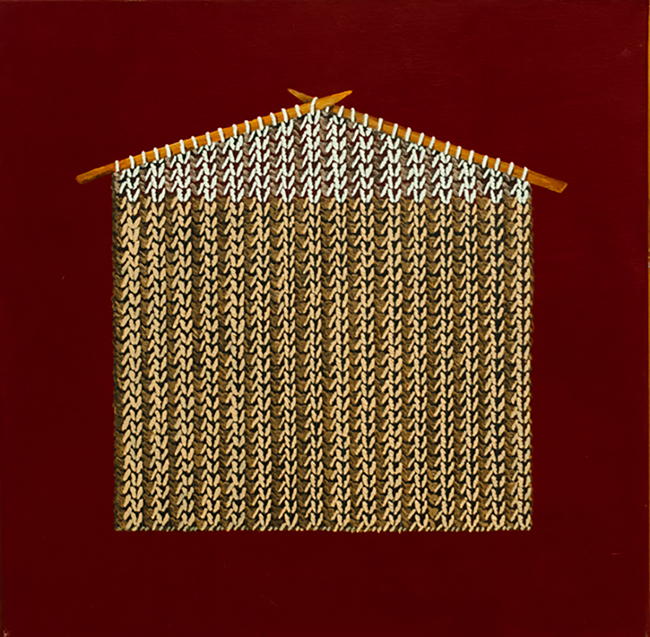דינה שצ׳ופק — ציורים סרוגים
שישי, 13.06.19 | שעה 12:00

אודות התערוכה
אמניות נשים בעשורים האחרונים מזדהות עם מלאכות נשים כמו רקמה, תפירה, הטלאה או סריגה ורואות בפרקטיקות האלה ביטוי משחרר, ואפילו אקט של התנגדות, ביחס לציור הגברי הקלאסי של שמן על בד. אך דינה שצ’ופק, ציירת ילידת ארגנטינה, 1931 (בת 88!), חברת קיבוץ מצר, אינה סורגת בחוטי צמר, או רוקמת בחוטי רקמה, אלא מציירת סריגות ורקמות תחרה במכחולים דקיקים, בטכניקה קפדנית, ובאיטיות סבלנית. הדימויים שלה חזיתיים ואיקוניים, יותר קונספטואליים מאשר ‘פרועים’ או משוחררים.
ההמרה הפנימית של מסורת ציור ‘גברית’ ואיקונית לטכניקה של מלאכה נשית אופיינית לשצ’ופק ולגישתה המכלילה. מי שמכיר את ההיסטוריה של הציור שלה ואת ההיסטוריה של הציור המודרניסטי מזהה את נקודות המפגש ביניהם – הריבוע השחור של קזימיר מלביץ’ שהוצג לראשונה ב 1915, כאחד משיאי האבנגרד של המאה העשרים וכמבשר חשוב של ההפשטה. שצ’ופק פגשה את הריבוע של מלביץ’ – מינימליסטי, גברי ורציונאלי – כסטודנטית לאמנות ואימצה אותו לתוך עבודתה. מאז היא שוזרת את שלוש הצורות הגיאומטריות המייצגות את הסופרמטיזם של מלביץ’ – ריבוע, עיגול ומלבן – לתוך שפה וזמן נשיים: שתי וערב, רקמת תחרה או סריגה. שצ’ופק לא הודפת את המסורת הגברית לאחור, אלא משנה אותה מבפנים. היא מזמינה את מלביץ’ לסרוג יחד איתה, עין שמאל – עין ימין – ושוב עין שמאל, לא בלי קריצה אל מונחים פוליטיים של שמאל וימין ואל מסורת הסוציאליזם שלאורה התחנכה כחברת קיבוץ.
בגדי התינוקות הסרוגים של שצ’ופק, סבתא לארבעה נכדים ושלוש נינות, אינם מִתְחמדים או מתפנקים. הסוודר הסרוג הוא גם חזית – אחת – של בית. בגד התינוק, בלי התינוק, מצויר בתנוחת צליבה. נעלי התינוק הסרוגות מצוירות בלבן פלומתי על רקע חאקי צבאי עם הכותרת “יונת השלום”: האופק הצבאי/ מלחמתי מאיים על כל רגע של הולדת. לצד אלה מופיע ה”חיבוק” של שני סוודרים ו”החזקת הידיים” של הכפפות הסרוגות.
ב -1996 הציגה שצ’ופק את התערוכה “נדוניה” שבה ציירה לבעלה, מרטין, את הנדוניה שלא הביאו איתם מקורדובה, עיר הולדתם: כריות וסדינים רקומים. ב”עוגת חתונה” (2001) אפתה עוגת חתונה אמתית בגובה התקרה. סרט וידיאו הראה זר של כלה נזרק באוויר, נופל ושוב נזרק: הרהור של שצ’ופק על מוסד הנישואין, שלא מוותר על מחוות אהבה לבן זוגה. אך בעיני עצמה היא תמיד “אישה עובדת” – ככותרת עבודת מפתח מוקדמת שלה, המשלבת גיאומטריה סופרמטיסטית, רקמת תחרה וגילוף בעץ של ריבוע-עיגול-מלבן. אישה עובדת ומציירת, מגלפת וסורגת.
אוצרת
טלי תמיר
נעילת התערוכה
13.10.19
Dina Schupak — Woven Paintings
Friday 13.09.19 | at 12:00
The internal conversion of the ‘masculine’ iconic painting paradigm into a female craft technique is characteristic of Schupak and her integrative approach. Anyone familiar with the history of her painting and the history of modernist painting recognizes their meeting point – Kazimir Malevich’s “Black Square”, first exhibited in 1915 as one of the pinnacles of twentieth century avant-garde, and a significant precursor of abstraction. Schupak encountered Malevich’s rectangle – minimalist, masculine and rational – as an art student and integrated it into her work. Ever since she has been weaving the three geometrical shapes representing Malevich’s Suprematism – square, circle, and rectangle – into female time and language: warp and woof, lace embroidery or knitting. Schupak does not cast-off the masculine tradition, but rather converts it from the inside. She invites Malevich to join her knitting, left eye – right eye – and again left eye, not without winking at political terminology of left and right and at a socialist tradition that she was educated in as a kibbutz member.
Knitted baby clothes by Schupak, grandmother of four and great-grandmother of three are not trying to be cute. The Knitted pullover is also a front –one – of a house. The baby bodysuit, painted without the baby, in a crucifying position. The knitted baby shoes, painted in downy white on a military khaki background, are titled “Peace Dove”: the military horizon menaces every moment of birth. Beside these, we see the “Hug” of two interwoven pullovers and the “Holding hands” of the knitted gloves.
In 1996 Schupak exhibited “Dowry” at the kibbutz gallery, where she painted for her husband, Martin, the dowry that they didn’t bring with them from Cordova, their home town: pillows and knitted sheets. In 2001 she exhibited her “Wedding Cake”, with a real wedding cake at its center – which Dina Schupak’s is famous for – built in layers and reaching as far as the ceiling. A video showed a bridal wreath thrown into the air, falling and thrown once again: Schupak’s reflection on the matrimonial institute, not renouncing love gestures to her partner. Yet, in her own eyes she is always a “Working Woman” – as stated by the title of her early key-work, combining Suprematist geometry, lace pattern and wood carving technique. A working woman works and paints, paints, carves and knits.
